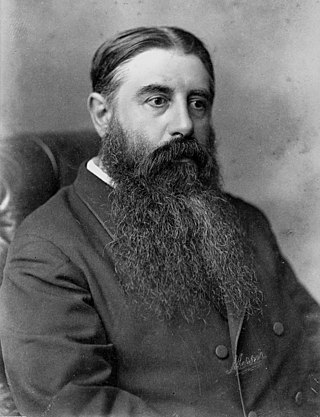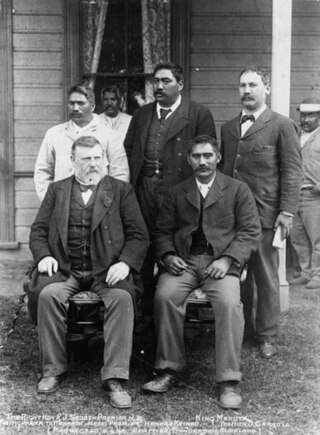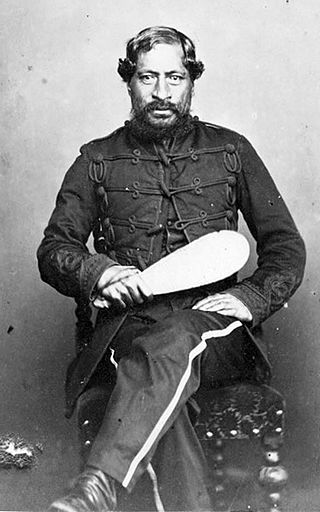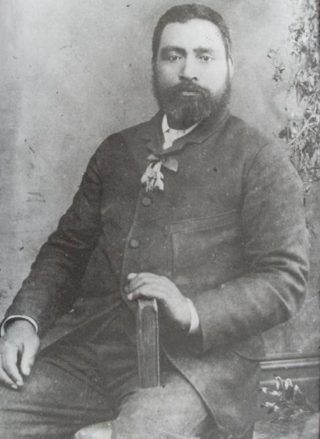
Te Keepa Te Rangihiwinui was a Māori military commander and noted ally of the government forces during the New Zealand Wars. First known as Te Rangihiwinui, he was later known as Te Keepa, Meiha Keepa, Major Keepa or Major Kemp.
William Morgan Crompton was a New Zealand politician.

The 1875–1876 New Zealand general election was held between 20 December 1875 and 29 January 1876 to elect a total of 88 MPs in 73 electorates to the 6th session of the New Zealand Parliament. The Māori vote was held on 4 and 15 January 1876. A total of 56,471 voters were registered.

The 1879 New Zealand general election was held between 28 August and 15 September 1879 to elect a total of 88 MPs to the 7th session of the New Zealand Parliament. The Māori vote was held on 8 September. A total of 82,271 (66.5%) European voters turned out to vote, plus 14,553 Māori voters. Following the election, John Hall formed a new government.

The 1899 New Zealand general election was held on 6 and 19 December in the European and Māori electorates, respectively, to elect 74 MPs to the 14th session of the New Zealand Parliament. The election was again won by the Liberal Party, and Richard Seddon remained Prime Minister.

Henare Kaihau was a New Zealand Māori politician, serving as Member of the House of Representatives for the Western Maori electorate.

Whanganui is a New Zealand parliamentary electorate. It was first established in 1860 for the 3rd Parliament and has existed continuously since then.
Western Maori was one of New Zealand's four original parliamentary Māori electorates established in 1868, along with Northern Maori, Eastern Maori and Southern Maori. In 1996, with the introduction of MMP, the Maori electorates were updated, and Western Maori was replaced with the Te Tai Hauāuru and Te Puku O Te Whenua electorates.

Wiremu Te Kākākura Parata, also known as Wi Parata was a New Zealand politician of Māori and Pākehā descent. During the 1870s he was a member of the House of Representatives and a Minister of the Crown.

Mete Kīngi Te Rangi Paetahi was a Member of Parliament in New Zealand. He was one of four Māori elected in the first Māori elections of 1868 for the new Māori electorates in the House of Representatives.

Hoani Nahe was a Māori historian and author, and a member of the House of Representatives from 1876 to 1879. His surname was spelt Nahi in some reports.
Wakanui was a rural parliamentary electorate in the south Canterbury region of New Zealand, from 1881 to 1887.
Ropata Te Ao was a nineteenth-century Māori member of the House of Representatives.
Hirini Rawiri Taiwhanga, known as Sydney Taiwhanga, was a 19th-century Māori member of the House of Representatives.

Wiremu Te Morehu Maipapa Te Wheoro (1826–1895), also known as Major Te Wheoro and later as Wiremu Te Morehu or William Morris, was a 19th-century Māori member of the House of Representatives.
Te Puke Te Ao was a 19th-century Māori member of the House of Representatives.
William Henry Colbeck was a 19th-century Member of Parliament in the Auckland Region of New Zealand.

The first Māori elections were held in 1868 in four newly formed Māori electorates during the term of 4th Parliament.

The 14th New Zealand Parliament was a term of the New Zealand Parliament. It was elected at the 1899 general election in December of that year.

Hāmiora Mangakāhia was a prominent Māori chief and the first Premier of Te Kotahitanga, the movement for an independent Māori parliament in New Zealand in the 1890s. Of Ngati Whanaunga descent, Mangakāhia was born in Waikaurau on the Coromandel Peninsula. In 1892 he was one of 19 chiefs elected to represent Te Tai Hauāuru in the Lower House of Te Kotahitanga at its first sitting at Waipatu Marae. As a leading organiser of the movement, he was nominated by fellow chiefs Henare Tomoana and Te Keepa Te Rangihiwinui to the position of Premier, which he held for the duration of the 1892 sitting of the parliament.













